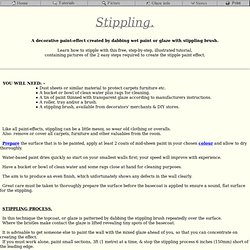

Using water based glazes. Using Acrylic Polymer (Water-based) Glazes Instead of Oil Like most Decorative Painters, I learned how to glaze walls and do faux finishes with mixtures of linseed oil, varnishes, alkyd glazes and other solvent-based mediums.

Since I started as a painter I also had many years prior exposure to solvents in painting airplanes, boats, oil tanks, churches, houses etc. All these years of daily exposure have an accumulative effect which I can feel now every time I work in a room with even mild levels of organic solvents. Thank goodness it is unnecessary to use oil-based glazes any more for large scale wall finishes. These new acrylic glazes will give you as much or more working time than oil-based glazes without a loss of quality as long as you follow a few simple rules and change your methods slightly. Acrylic glazes must be applied more thickly than solvent-based glazes so they can keep their open time. Try paint spattering for faux stone effects and more. In the 1960 and early 1970s, paint spattering was a common faux finish on furniture in the "blonde" French provincial style so popular at the time.

The tiny raw umber speckles gave the furniture a feel of age, even though it may have been manufactured just weeks before. While it's not as common to see this finish on furniture today, it remains a valuable faux finish technique. Imitating Stone Anyone who has spent any time in nature knows that stones are often mixture of many colors. In fact, they can appear to almost be made up of numerous little speckles. Add spattering paint on top of a faux stone finish such as granite will really give it a genuine look.
Adding Character Paint spattering doesn't have to be used for antiquing like it was in the 60s. Using water based glazes. Color Washing Paint Technique - Color Washing Walls Painting Technique. Envision the walls of a room bathed in the ethereal hues of twilight.

Using the color washing painting technique, you can give any room in your home a more inviting look and feel. Color Washing: Paint Tools and Supplies 3-inch or 4-inch Benjamin Moore paint brush or soft rags (brushes will lend a textured look, while rags will result in a softer, more diffuse, finished appearance) Regal® Matte Finish (N221) with Advanced Particle Technology™ Studio Finishes® Latex Glaze (405) Disposable latex gloves Drop cloth Paint tray Painter's tape Water for cleanup Step 1 - Prepare your walls Whether you are color washing your walls or another surface, be sure any surface is properly prepared before you begin glazing. Lour from www.painting-effects.co.uk. How To Stencil - Videos. How to Stencil Guide from Henny Donovan. What is Stencilling?

Stencilling is a fantastic decorating medium for creating up to the minute style and your own interior design statement. It is great for beginners and professionals alike, allowing you to print/transfer an already designed pattern onto a surface using paint, as many times as you like and in as many different arrangements, finishes and colours as you like. 10 Tips for a Perfect Paint Job: The Family Handyman.
STIPPLING TUTORIAL _____ Step-by-step instructions for stippling _____ Illustrated Tutorial ______ from www.painting-effects.co.uk. Stippling.

A decorative paint-effect created by dabbing wet paint or glaze with stippling brush. Learn how to stipple with this free, step-by-step, illustrated tutorial, containing pictures of the 2 easy steps required to create the stipple paint effect. Dust sheets or similar material to protect carpets furniture etc. A bucket or bowl of clean water plus rags for cleaning. A tin of paint thinned with transparent glaze according to manufacturers instructions. Like all paint-effects, stippling can be a little messy, so wear old clothing or overalls.
Prepare the surface that is to be painted, apply at least 2 coats of mid-sheen paint in your chosen colour and allow to dry thoroughly. Water-based paint dries quickly so start on your smallest walls first; your speed will improve with experience. Have a bucket or bowl of clean water and some rags close at hand for cleaning purposes. The aim is to produce an even finish, which unfortunately shows any defects in the wall clearly. !!!